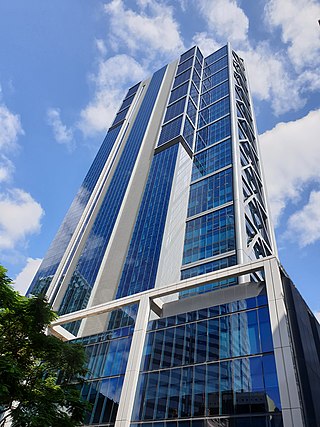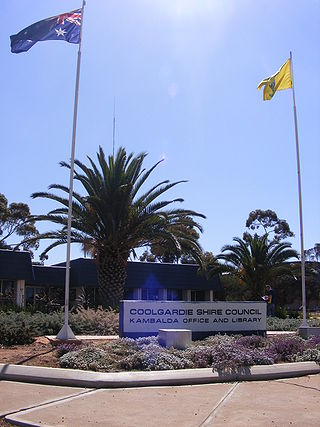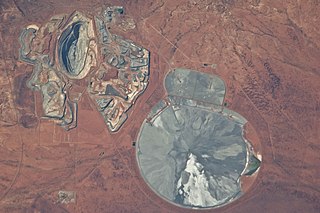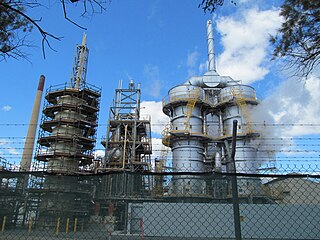
BHP Group Limited is an Australian multinational mining, metals, natural gas petroleum public company that is headquartered in Melbourne, Victoria, Australia.

Vale Canada Limited is a wholly owned subsidiary of the Brazilian mining company Vale. Vale's nickel mining and metals division is headquartered in Toronto, Ontario, Canada. It produces nickel, copper, cobalt, platinum, rhodium, ruthenium, iridium, gold, and silver. Prior to being purchased by CVRD in 2006, Inco was the world's second largest producer of nickel, and the third largest mining company outside South Africa and Russia of platinum group metals. It was also a charter member of the 30-stock Dow Jones Industrial Average formed on October 1, 1928.
Falconbridge Limited was a Toronto, Ontario-based natural resources company with operations in 18 countries, involved in the exploration, mining, processing, and marketing of metal and mineral products, including nickel, copper, cobalt, and platinum. It was listed on the TSX and NYSE (FAL), and had revenue of US$6.9 billion in 2005. In August 2006, it was absorbed by Swiss-based mining company Xstrata, which had formerly been a major shareholder.

Xstrata plc was an Anglo-Swiss multinational mining company headquartered in Zug, Switzerland and with its registered office in London, United Kingdom. It was a major producer of coal, copper, nickel, primary vanadium and zinc and the world's largest producer of ferrochrome. It had operations in 19 countries across Africa, Asia, Australasia, Europe, North America and South America.

Ravensthorpe is a town 541 km south-east of Perth and 40 km inland from the south coast of Western Australia. It is the seat of government of the Shire of Ravensthorpe. At the 2006 census, Ravensthorpe had a population of 438.

Kambalda is a small mining town about 60 kilometres (37 mi) from the mining city of Kalgoorlie in Western Australia, within the Goldfields. It is split into two townsites 4 kilometres (2.5 mi) apart, Kambalda East and Kambalda West; and is located on the western edge of a giant salt lake, Lake Lefroy. At the last census, Kambalda had a combined population of 2,468.

Mining in Australia has long been a significant primary sector industry and contributor to the Australian economy by providing export income, royalty payments and employment. Historically, mining booms have also encouraged population growth via immigration to Australia, particularly the gold rushes of the 1850s. Many different ores, gems and minerals have been mined in the past and a wide variety are still mined throughout the country.

Mining in Western Australia, together with the petroleum industry in the state, accounted for 94% of the State's and 46% of Australia's income from total merchandise exports in 2019–20. The state of Western Australia hosted 123 predominantly higher value and export-oriented mining projects and hundreds of smaller quarries and mines. The principal projects produced more than 99 per cent of the industry's total sales value.

Mount Keith Mine is an open pit nickel mine in Western Australia. It is operated by BHP. The site's closest landmark is the town of Wiluna, 85 kilometres (53 mi) to the north.
The mining industry of Botswana has dominated the national economy of Botswana since the 1970s. Diamond has been the leading component of the mineral sector since large-scale diamond production began in 1972 by Debswana. Most of Botswana's diamond production is of gem quality, resulting in the country's position as the world's leading producer of diamond by value. Copper, gold, nickel, coal and soda ash production also has held significant, though smaller, roles in the economy.
The Yeelirrie uranium project is a uranium deposit located approximately 70 km southwest of Wiluna, in the Mid West region of Western Australia. The name Yeelirrie is taken from the local sheep station.

Nickel mining in Western Australia has been an industry that has had many fluctuations of fortune in its history. Large fluctuations in the world nickel price have seen mines close and reopen on several occasions.

The Olympic Dam mine is a large poly-metallic underground mine located in South Australia, 550 km (340 mi) NNW of Adelaide. It is the fourth largest copper deposit and the largest known single deposit of uranium in the world. Copper is the largest contributor to total revenue, accounting for approximately 70% of the mine's revenue, with the remaining 25% from uranium, and around 5% from silver and gold. BHP has owned and operated the mine since 2005. The mine was previously owned by Western Mining Corporation.

South32 is a mining and metals company headquartered in Perth, Western Australia. It was spun out of BHP Billiton on 18 May 2015. It is listed on the Australian Securities Exchange with secondary listings on the Johannesburg and London Stock Exchanges.
Gencor Ltd was a South African based mining company. It was formed in 1980 after the merger of the General Mining and Finance Corporation and the Union Corporation. Parts of the company are now owned by Gold Fields and BHP.
Leinster Nickel Mine is a surface and undergorund nickel mine, 5 km north of Leinster, Western Australia. The deposit was discovered in 1971 and the mine opened in 1978, operated by the Agnew Mining Company. It was purchased by WMC Resources in 1988 which, in turn, was taken over by BHP in 2005.

The Kwinana Nickel Refinery is a nickel refinery in East Rockingham and Kwinana Beach, Western Australia. The refinery is operated by BHP and part of its Nickel West operations. Having originally been built by WMC Resources, it changed ownership in 2005 when BHP acquired WMC.
The Kalgoorlie Nickel Smelter is a nickel smelter in Feysville, south of the town of Kalgoorlie in Western Australia. The refinery is operated by BHP and part of its Nickel West operations. Having originally been built by WMC Resources, it changed ownership in 2005 when BHP acquired WMC.

Kambalda Nickel Operations or Kambalda Nickel Mine is a surface and underground nickel mine as well as a nickel concentrator, near Kambalda East, Western Australia. The deposit was discovered in 1954 and the mine opened in 1967, operated by WMC Resources which was taken over by BHP in 2005. Prior to this, between 20001 and 2003, WMC ceased mining operations at Kambalda and divested itself of the mining assets.












